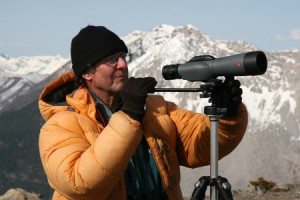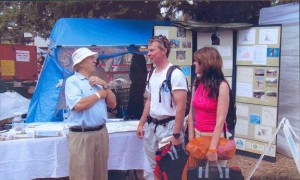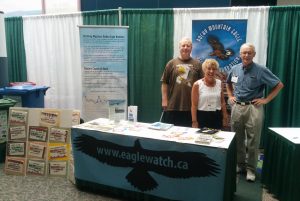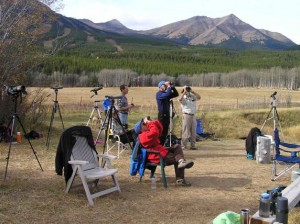Learn More
Formal Speaking Engagements
Research Director Peter Sherrington delivers scientific and entertainingly humorous presentations about the Rocky Mountains Raptor Migration.

Peter Sherrington watching for Eagles
Peter has spent a lifetime studying birds and nature in many parts of the world. His greatest contribution is his intensive study of the migration of Golden Eagles and other raptors in the Rocky Mountains.
Peter discovered this massive migration of Golden Eagles in 1992. Before that North American Golden Eagles were thought to be generally sedentary, like most other populations of this bird around the world.
Peter has given numerous presentations to technical societies, academic groups, school classes, and enthusiasts of nature. His vast knowledge of the subject is conveyed to audiences of all levels in an easily understood manner with a natural flow of information sprinkled with anecdotes.
Peter previously spent 20 years as a research paleontologist and geologist in the oil industry.
To discuss Peter’s or another speaker’s availability please Contact us.
Informal Presentations made at Events.
During the year RMERF attends a number of events where our tent and display materials are set up and where members of the board and other volunteers meet with and talk to hundreds of people. Through these conversations a wide cross-section of the public is made aware of the unique migration of golden eagles that takes place close by, and we frequently create useful contacts. Many of the interested people are from other countries. Many are local young people.

RMERF display booth

Mayor’s Environment Expo
CR David Sweeney
The list of events attended is increasing every year. Dates and locations are covered in the Events Page. Some of the events regularly attended are:
AWA (Alberta Wilderness Association) Tower Climb
Inglewood Bird Sanctuary Migration Day,
Alberta Provincial Parks Day
University of Calgary Field Station (Barrier Lake, Kananaskis) open house
Canmore Folk Festival where a number of other environmental groups are in attendance
Canmore’s formally called Festival of Eagles, where we provide expert guidance and optical equipment
Informal Presentations at the Hay Meadow Observation Site
There is absolutely no doubt that the best place to learn about eagles and other raptors and their migration is in the field.
During the eight weeks of raptor migration in both the spring and the fall, the Hay Meadow site has personnel from dawn to dark. There is at least one highly experienced Principal Observer, and on most days he or she has a helper in attendance. Visitors are most welcome and either the Principal Observer or the helper will give short coverage of what is happening. There will be some spare binoculars available, but visitors should bring their own if they have them. On those days when large numbers of eagles are moving along the mountain ridges, the observers may be so busy that they will press visitors to assist them. Visitors are encouraged to take an active part in spotting eagles or other raptors and bringing them to the observer’s notice. The sky is very big and the eagles are very high and fast. All eyes are welcome.
All Principal Observers and most of the assistants are well versed in bird recognition and some of them are also experts in local botany, mammals and/or butterflies etc. They spend a great deal of time scanning the peaks and mountain cliffs by binocular for passing raptors and in the course of this activity see Mountain Goat, Bear and Bighorn Sheep which would otherwise go unnoticed. If mammals have been seen, and are still around, they will be pointed out to visitors.
Although Hay Meadow offers very good learning opportunity, it also offers sudden changes in weather conditions. Raptor spotting can become a very cold experience. Visitors are advised to bring extra layers; and if they intend spending some time with us, a light camp or garden chair would add to their comfort.

Nice fall day at Hay Meadow. Mt.Allan left middle, Mt Colombola on right.
Or would you prefer this

Group of observers and visitors. Hay Meadow
Working with schools and community groups
For groups interested in field golden eagles observation or talks, RMERF would be prepared to meet and prepare a specific itinerary.
More recently the RMERF has approached the Alberta Teachers Association, and with their encouragement and support, is working on the development of a pilot program of raptor observation and studies, including field time. A specific high school close to the one of the observation sites is preparing a proposal for integrating golden eagles observation and studies into their curriculum, covering all aspects from biology, ecology, math / statistics, social studies & culture, etc. RMERF would be prepared to fund costs of special equipment, materials, field trips and related eligible expenditures.
Once tested in practice, such a program could be implemented together with other interested schools as well.
Learning on the Internet
There are a number of excellent sources of eagle knowledge available on the web.
In the late 1990s Carol McIntyre, wildlife biologist at Denali National Park in Alaska, organized the attachment of telemetry devices to tail feathers of newly fledged golden eagles and collected data on their fall movement to wintering grounds and back the following spring. These data and maps of the migrations are available at the following web site.
https://www.nps.gov/akso/nature/science/ak_park_science/PDF/2006Vol5-1/Golden-Eagles.pdf
The Raptor View Research Institute in Missoula, Montana captured an adult female golden eagle in 2010 and attached a long lasting position transmitting device to her. At first she didn’t move far and the group was worried that she might be non migratory. However off she went to Alaska and she provided excellent data regarding her migrations until early spring 2013. She was named Elaine. For great description of the capture etc. go to the Institute’s web site. It also provides data and videos of Kramer and other satellite tracked golden eagles and other raptors.

